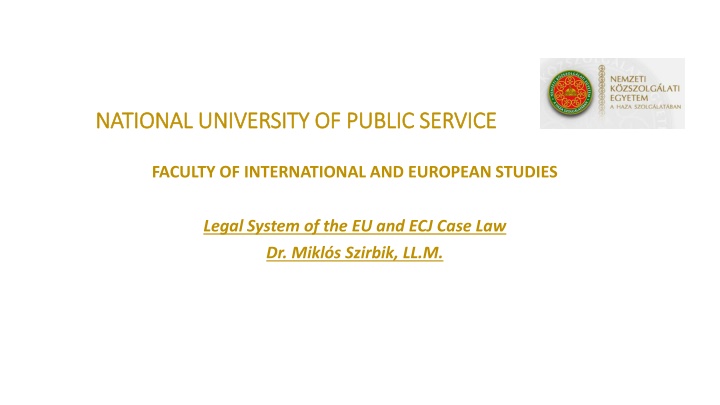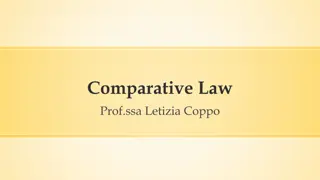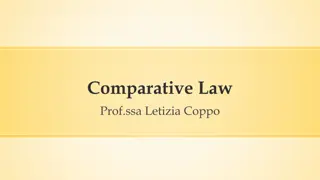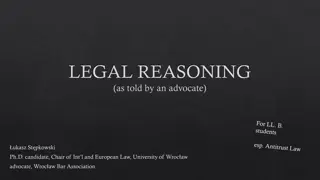Legal System of the EU and ECJ Case Law Overview
The EU Commission's infringement procedure for possible violations of EU law, the formal steps involved, and the role of the Court of Justice in ensuring compliance with EU regulations. Dr. Mikls Szirbik, an expert in EU legal matters, provides insights into the legal framework and procedures.
Download Presentation

Please find below an Image/Link to download the presentation.
The content on the website is provided AS IS for your information and personal use only. It may not be sold, licensed, or shared on other websites without obtaining consent from the author.If you encounter any issues during the download, it is possible that the publisher has removed the file from their server.
You are allowed to download the files provided on this website for personal or commercial use, subject to the condition that they are used lawfully. All files are the property of their respective owners.
The content on the website is provided AS IS for your information and personal use only. It may not be sold, licensed, or shared on other websites without obtaining consent from the author.
E N D
Presentation Transcript
NATIONAL NATIONAL UNIVERSITY UNIVERSITY OF OF PUBLIC PUBLIC SERVICE SERVICE FACULTY OF INTERNATIONAL AND EUROPEAN STUDIES Legal System of the EU and ECJ Case Law Dr. Mikl s Szirbik, LL.M.
Mikls Szirbik, Mikl s Szirbik, Mikl s Mikl s Szirbik Szirbik, Legal System of the EU , Legal System of the EU Infringement procedure The Commission identifies possible infringements of EU law on the basis of its own investigations or following complaints from citizens, businesses or other stakeholders. If the EU country concerned fails to communicate measures that fully transpose the provisions of directives, or doesn t rectify the suspected violation of EU law, the Commission may launch a formal infringement procedure. The procedure follows a number of steps laid out in the EU treaties, each ending with a formal decision:
Szirbik, EU Jogrendszere Szirbik, EU Jogrendszere Infringement procedure Legal Bais Art. 4 EUT 4. cikke loyal cooperation priciple; Art. 17 EUT tasks of EU Commission Art 258. TFEU / Art. 106a. EURATOM Infringement procedure
Mikls Szirbik, Mikl s Szirbik, Mikl s Mikl s Szirbik Szirbik, Legal System of the EU , Legal System of the EU Formal procedure 1. Formal notice The Commission sends a letter of formal notice requesting further information to the country concerned, which must send a detailed reply within a specified period, usually 2 months.
Mikls Szirbik, Mikl s Szirbik, Mikl s Mikl s Szirbik Szirbik, Legal System of the EU , Legal System of the EU Formal procedure 2. Reasoned opinion If the Commission concludes that the country is failing to fulfil its obligations under EU law, it may send a reasoned opinion: a formal request to comply with EU law. It explains why the Commission considers that the country is breaching EU law. It also requests that the country inform the Commission of the measures taken, within a specified period, usually 2 months.
Mikls Szirbik, Mikl s Szirbik, Mikl s Mikl s Szirbik Szirbik, Legal System of the EU , Legal System of the EU Formal procedure 3. Court of Justice If the country still doesn't comply, the Commission may decide to refer the matter to the Court of Justice. Most cases are settled before being referred to the court.
Mikls Szirbik, Mikl s Szirbik, Mikl s Mikl s Szirbik Szirbik, Legal System of the EU , Legal System of the EU Formal procedure 4. Penalties upon initiative of the Commission issued by the Court If an EU country fails to communicate measures that implement the provisions of a directive in time, the Commission may ask the court to impose penalties.
Mikls Szirbik, Mikl s Szirbik, Mikl s Mikl s Szirbik Szirbik, Legal System of the EU , Legal System of the EU Formal procedure 5. Court judgment If the court finds that a country has breached EU law, the national authorities must take action to comply with the Court judgment.
Mikls Szirbik, Mikl s Szirbik, Mikl s Mikl s Szirbik Szirbik, Legal System of the EU , Legal System of the EU Non-compliance with a court decision If, despite the court's judgment, the country still doesn't rectify the situation, the Commission may refer the country back to the court. Financial penalties When referring an EU country to the court for the second time, the Commission proposes that the court impose financial penalties, which can be either a lump sum and/or a daily payment.
Mikls Szirbik, Mikl s Szirbik, Mikl s Mikl s Szirbik Szirbik, Legal System of the EU , Legal System of the EU Financial penalties The above mentioned penalties are calculated taking into account: the importance of the rules breached and the impact of the infringement on general and particular interests the period the EU law has not been applied the country's ability to pay, ensuring that the fines have a deterrent effect The amount proposed by the Commission can be changed by the court in its ruling.
Mikls Szirbik, Mikl s Szirbik, Mikl s Mikl s Szirbik Szirbik, Legal System of the EU , Legal System of the EU COMMUNICATION FROM THE COMMISSION Modification of the calculation method for lump sum payments and daily penalty payments proposed by the Commission in infringements proceedings before the Court of Justice of the European Union (2019/C 70/01) https://eur-lex.europa.eu/legal- content/EN/TXT/?uri=uriserv%3AOJ.C_.2019.070.01.0001.01.ENG
Mikls Szirbik, Mikl s Szirbik, Mikl s Mikl s Szirbik Szirbik, Legal System of the EU , Legal System of the EU Financial sanctions Under the Treaty on the Functioning of the European Union (TFEU), when the Commission refers a Member State to the Court of Justice of the European Union for having infringed EU law, the Court may impose financial sanctions in two situations: 1. When the Court has ruled that a Member State infringing EU law has not yet complied with an earlier judgment finding that infringement (Article 260(2) TFEU); 2. When a Member State has failed to fulfil its obligation to notify measures transposing a Directive adopted under a legislative procedure (Article 260(3) TFEU).
Mikls Szirbik, Mikl s Szirbik, Mikl s Mikl s Szirbik Szirbik, Legal System of the EU , Legal System of the EU Financial sanctions Since 1997 and as set out in successive Communications, it has applied an approach which reflects both the capacity to pay of the Member State concerned, and its institutional weight. This is applied through what is known as the n-factor . This combines with other factors the seriousness of the infringement, and its duration in the Commission's calculation of a proposed sanction. Until now, the n-factor has been calculated with reference to the gross domestic product (GDP) of a Member State, and the number of votes allocated to it in the Council.
Mikls Szirbik, Mikl s Szirbik, Mikl s Mikl s Szirbik Szirbik, Legal System of the EU , Legal System of the EU Financial sanctions The Court of Justice has recently established that the Council voting rules can no longer be used for this purpose. Consequently, it would rely on the Member States' GDP as predominant factor. The Commission has always considered that sanctions need both to act as a deterrent, and to be proportionate, and the proposals it makes to the Court for its final decision should already reflect this need. The combination of a Member State's capacity to pay and its institutional weight provided this balance. Use of GDP alone would upset this equilibrium, as it would exclusively reflect the economic dimension of Member States. It would have very different impacts for different Member States and in particular suggest a substantial increase in the amounts of the proposed sanctions for more than a third of the Member States. The Commission therefore considers that the n-factor should continue to reflect both GDP and institutional weight.
Mikls Szirbik, Mikl s Szirbik, Mikl s Mikl s Szirbik Szirbik, Legal System of the EU , Legal System of the EU Financial sanctions Given the Court's judgment, a new reflection of institutional weight to be used in the calculation of financial sanctions is needed. In order to maintain the balance between the capacity to pay and the institutional weight of a Member State, the Commission will calculate the n-factor on the basis of two elements: GDP, and the number of seats for representatives in the European Parliament allocated to each Member State. The Commission considers that this is the most appropriate reflection of institutional weight of Member States available today in the EU Treaties.
Mikls Szirbik, Mikl s Szirbik, Mikl s Mikl s Szirbik Szirbik, Legal System of the EU , Legal System of the EU Financial sanctions The respective standard flat-rate amounts used for calculating the daily penalty payments and the lump sum payments are consequently adjusted as follows: Standard flat-rate amount for daily penalty payments: EUR 690 4,5 = EUR 3 105; Standard flat-rate amount for lump sum payments: EUR 230 4,5 = EUR 1 035. Following the same logic, the current reference minimum lump sum amount of 571 000 EUR will also be multiplied by the new n-factor to calculate the minimum lump sum amount for each Member State. In order to ensure that the amounts proposed are proportionate and sufficiently deterring, that amount will also be multiplied by the adjustment factor: EUR 571 000 4,5 = EUR 2 569 500. These amounts will be revised annually, in line with inflation.
Mikls Szirbik, Mikl s Szirbik, Mikl s Mikl s Szirbik Szirbik, Legal System of the EU , Legal System of the EU Financial sanctions See full list of countries here: https://eur-lex.europa.eu/legal-content/EN/TXT/?uri=uriserv%3AOJ.C_.2019.070.01.0001.01.ENG Belgium 0,79 Bulgaria 0,24 Czech Republic 0,51 Denmark 0,50 Germany 4,60 Estonia 0,09 Ireland 0,46 Greece 0,51 Spain 2,06 France 3,40
Thank you for your attention! Thank you for your attention!























